Bringing your product to your consumer needs to be an excellent experience. From the look to the feel to the longevity of your products, how well are your products comparing with similar products in the market? Shrinkwrapping is an easy process requiring two basic elements: the right kind of shrink film and heat. With just a roll of shrink film and a heating source, you have all the tools you need to waterproof, weatherproof and tamperproof just about anything, regardless of size. You'll also be able to bring a layer of confidence to your consumer, and stand out with the protective shine of shrink wrap when applied appropriately!
Given the flexibility, durability, and other valuable advantages of using shrink film, many companies employ this option to package their products. To bring your products to the market with shrink film, this guide will give you all you need to know including what shrink film is, what it’s typically used for, what types are available, and how each benefits different products, how much shrink film costs, and whether it’s right for your business. This guide is a comprehensive source of information about shrink wrap for product packaging.
Begin reading the full guide below, or fill out the form here for a free downloadable PDF version that you can reference later.
Once the form is filled out, you will be able to download the entire guide immediately, and you'll receive it via email!
Scroll down to read the guide without filling out the form.
Begin reading the full guide below, or fill out the form here for a free downloadable PDF version that you can reference later.
Once the form is filled out, you will be able to download the entire guide immediately, and you'll receive it via email!
Scroll down to read the guide without filling out the form.
Shrink wrap (also referred to as shrink film or shrink wrap) is a versatile polymer material used for the packaging of finished goods. Heat is applied to the film – by either a conveyor heat tunnel or an electric or gas heat gun – which catalyzes the film to shrink tightly around the item placed within. This process results in a clear, durable barrier of protection around the product.
So, how exactly does this happen? The science of shrink wrap can be explained in terms of molecular behavior. The molecules of a shrink film sheet or tube are randomly intertwined, meaning they are coiled and twisted with no particular alignment. When the film is warmed, the structureless regions of the chains are straightened and aligned to the direction of orientation. More simply, the molecules reorient from their initial random pattern to ultimately fit the mold of their contents. When cooled properly, the film’s molecular characteristics are set, so it remains in this stretched state until sufficient heat energy is applied for the molecule chains to shrink back to their original form.
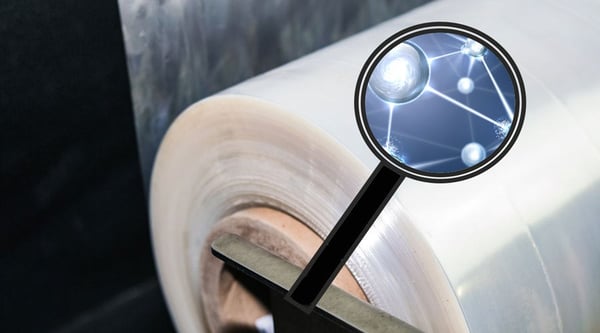
Shrink wrap film is available in a variety of types, thicknesses, clarities, strengths, and shrink ratios, which can be employed alone or in conjunction with one another to create the precise type of layering and protection for your product. These options and constructions have broadened over time to accommodate specific requirements for sealability, optics, toughness, slip, temperature, force, and memory.
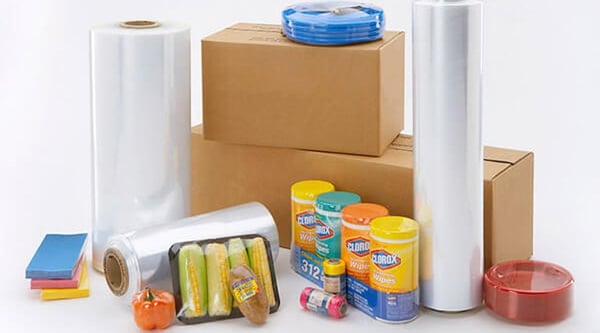
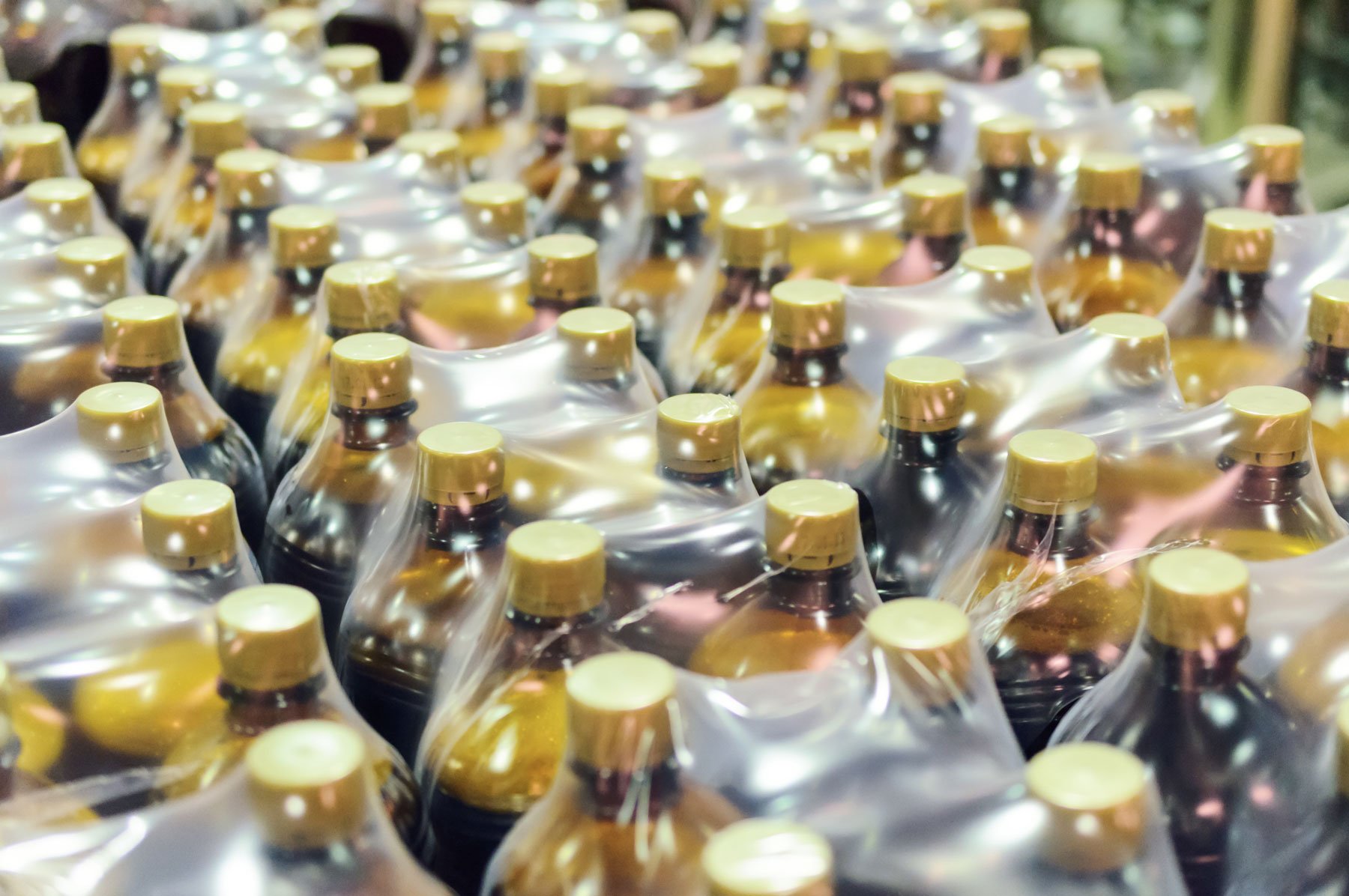
This FREE eGuide to Shrink Film is filled with tips to reduce costs and prevent product damage with shrink! Learn about multilayer films, film selection and more

Below are 7 characteristics that detail some functions of shrink film. These are important to consider when using it for your product packaging.
This is typically measured in PSI, and tells you the amount of force that the shrink film will exert on your product. If you're packaging a multi-pack that needs to be tightly contained without damaging, understanding your shrink force is very helpful, especially for adjusting your shrink machinery accordingly. If the shrink force is high and you're packaging wood, this won't matter.
However, if you are packaging a small stack of paper or lightweight chipboard boxes, this could matter. Historically, polyolefin films are high shrink force films. Polyvinyl chloride (PVC) films have low shrink force. New polyolefin formulations offer reduced amounts of shrink force.
Shrink films are either bi-axially oriented or preferentially oriented. Bi-axially oriented films shrink equally in both directions (Machine Direction or Cross Direction).*
Preferentially oriented film shrinks differently in either direction. The benefits of a preferentially oriented film include using less film and preventing product distortion.
In addition to altering your shrink percentages by using preferentially oriented film, you can also lower the shrink percentage and stay with a bi-axially oriented film e.g. 40/40 30/30, 20/20.
Another related characteristic is Free Shrink. Unfortunately, this isn't a tip to get free shrink wrap, but it's just as important. I know, I know... Free shrink is the amount of shrink-ability in a film before it makes contact with your product. High levels of free shrink allow you to get a better-looking package on difficult shapes and sizes.
This measures how hard it is to actually break the film, and how hard it is to tear the film once it has been punctured.
Often, films with high resistance to puncture have lower resistance to tear and vice versa. If you need to make this trade-off, select the characteristic that is more important (e.g., if you have a window box, puncture resistance is very important). Choose a shrink film that balances the security of your product with ease of access to the actual product. Be sure to keep your shrink wrap stored in a cool (but not too cool) storage area to prevent any weakening of the film prior to use.
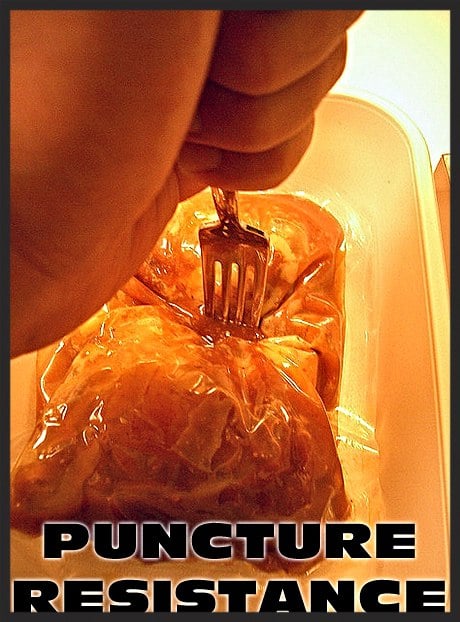
This characteristic is a measure of how much moisture will or will not travel through the film.
If low moisture transmission into or out of your package is important, you should pay attention to this characteristic for improved shelf life. Something you will want to consider for this and to reduce or eliminate fog is modified atmosphere packaging.
Antifog films are used on food (fresh and frozen) to mitigate moisture build-up on the film.
The moisture can cause a fog that affects the viewing of the product through the film. (If I'm buying something, you bet that I'm skipping over the fogged-up package for the one with the product I can actually see).
Odor barrier films are used to prevent unacceptable odors from either traveling into or out of your package. Don't disappoint your customers after they've purchased your product with a foul smell. Enough said.
There are a few common types of shrink film available. Learn about how each works best for different products.
To protect and secure products for retail and shipping environments, there are three main types of films used in shrink wrapping: polyvinyl chloride, polyolefin and polyethylene. Each of these materials features different capabilities and characteristics that make them suitable for specific applications. In addition, each one can be co-extruded into multilayer films with different additives in order to create distinct barrier properties that promote shelf life or a particular appearance.
Shrink films can be formed into flattened roll stock, bags, overwrap, banding, and tubing. They can add a form of tamper-resistant protection to packaged goods. Here's a breakdown of the three main shrink film types and their common uses:
Given its lightweight nature, inexpensiveness, and multi-purpose capabilities, PVC was once the most commonly used shrink packaging material in the world. It has since given way to polyethylene (PE) and polyolefin (POF) for a number of reasons, including the health dangers posed during creation and incineration, as well as its level of sustainability.
In its rigid form, PVC is durable and used in such applications as construction projects and houseware products. In terms of packaging, PVC is applied to both rigid constructs (like blister and clamshell packaging) and flexible ones (like shrink film and bagging).
PVC comprises a combination of three elements: carbon, hydrogen, and chlorine. Due to the strong, harmful odors that are released when heated, it is recommended for use in well-ventilated facilities. In fact, it is banned altogether in some countries because of its chemical composition and the harmful byproducts released during creation and decomposition. Even in countries where it is legal, brands that are committed to corporate and social responsibility have banned PVC in their own packaging process. For example, the Walmart Sustainability Playbook specifically targets PVC reduction in packaging materials used by the manufacturers of products sold in their stores. If you utilize a PVC film, it’s critical to ensure the highest possible standards for use and disposal across your supply chain.
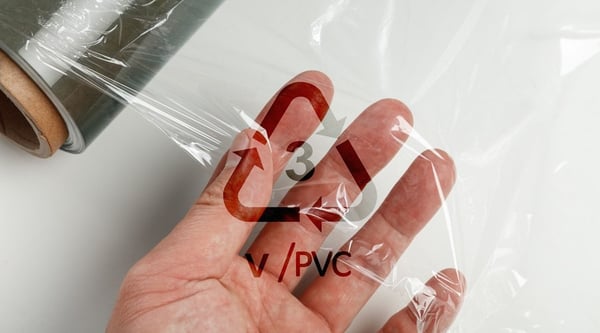
A notable downside to PVC is its reaction to hot and cold temperature changes. It can become brittle under certain low temperatures and subject to wrinkling under certain high temperatures. Its resistance to tearing after being punctured is on the higher side, but its resistance to being punctured is on the lower side.
This type of film is not ideal for bundling multiple items together, given its more brittle nature after shrinking. PVC is also known to leave carbon deposits on the sealer, which means proper and regular maintenance is required for consistent operation. It offers preferential orientation (shrinks in only one direction) and exerts low shrink force on a product. It is a #3 recyclable material, which means it is unable to be recycled in most cases.
PVC is leveraged in a number of applications in the building and construction industries, as well as the healthcare, electronics, and automobile sectors, among others. It’s used for products ranging from piping and siding to blood bags and tubing, wire and cable insulation, windshield system components, blister packs, clamshells, and more. Applications for PVC shrink film include packaging of CDs and DVDs, boxes for gaming and software, and other non-edible items.
Polyolefin shrink film is extremely durable and versatile, making it a premium option. It has taken the place of PVC in many applications and is an FDA-approved food-safe material. POF materials are available with different characteristics. One option is cross-linked film, which provides high-tensile strength and incredible clarity for high-speed packaging applications. Cross-linked film also prevents buildup on the sealing components of your machinery.
Because of POF’s added strength, longer rolls of film with thinner gauges can be created. This decreases roll change-over and increases both efficiency and productivity. POF shrink film has excellent puncture resistance and seal strength, which helps protect irregularly shaped items throughout its supply chain lifecycle. POF is available in thicknesses as low as 35-gauge (.35 mil) and is more commonly available in 45, 60, 75, and 100 (1 mil) gauges.
The versatility and reasonable cost that POF lends to multiple machines and packaging forms make it a go-to option for protective packaging manufacturers of any size. In some instances, POF film requires the addition of perforations, or tiny holes, before application. These holes allow air to escape during the shrinking process in order to produce a smooth package with an even shrink surface and no air pockets. Pre-perforated shrink film is available by many suppliers for this reason.
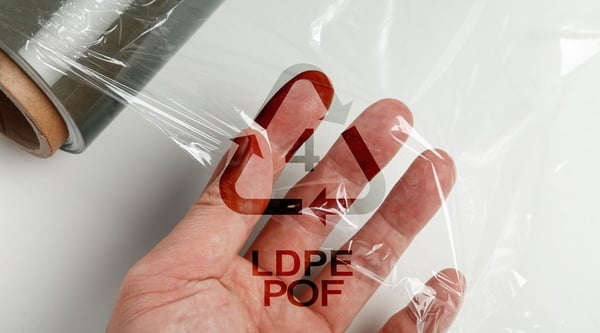
POF is made of 100% recyclable materials. With its superb clarity and glossy shelf appearance, this shrink film is optimal for consumer products for which presentation is critical. It’s also good for bundling multiple items together, like tissue boxes. POF is durable and less affected by temperature changes. It features excellent tensile strength and propagation to tear, and it has the ability to shrink quickly and completely, resulting in a finished good as soon as it comes out of the shrink tunnel.
Common uses for POF shrink film include toys, games, candies, books, foods, most retail items, and any consumer product where appearance is important. When we say it's versatile, we aren't kidding! Depending on your need for barrier layers or MVTR, additives can be combined to give you exactly what you need with this packaging film.
Polyethylene is a type of polyolefin, meaning it is a single monomer film that is formed with the addition of ethylene during polymerization. PE is used in several forms of flexible protective packaging, including shrink film and stretch film, performing very differently for each.
The three most common forms of PE include High-Density Polyethylene, Low-Density Polyethylene, and Linear Low-Density Polyethylene.
High-density polyethylene (HDPE) or polyethylene high-density (PEHD) is a polyethylene thermoplastic made from petroleum. With a high strength-to-density ratio, HDPE is used in the production of plastic bottles, corrosion-resistant piping, geomembranes, and plastic lumber. HDPE is commonly recycled in both its rigid form (e.g., containers) and its flexible form (e.g., bags), and it uses the #2 resin identification code.
Due to its exceptional versatility, it is the most widely utilized of plastics and is applied to a wide spectrum of products, from hard hats to milk jugs. Common uses include beverage bottles, personal care products (e.g., shampoo), and household products. The bread bags and thin plastic produce bags provided in grocery stores are made from HDPE, as are cereal box liners. It's also used in more heavy-duty stretch-wrapping situations, such as bundling produce on farms. It usually comes on a roll similar to other films but is more of a net that offers breathability to the products it wraps.
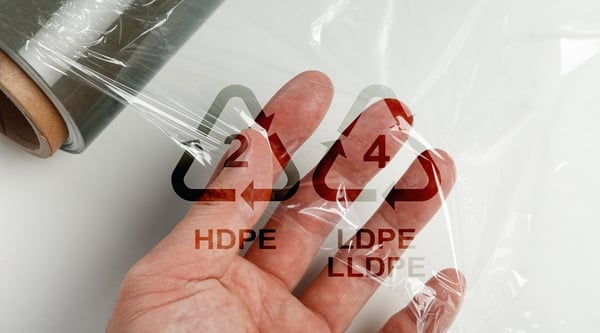
While similar to high-density polyethylene, LDPE has a lower density (as the name suggests). This means that it has less mass compared to its volume. LDPE is highly resistant to impact, moisture, and chemicals. It’s also widely recycled, and rigid LDPE products (e.g., bottles, containers, lids, caps, etc.) are typically collected in curbside recycling programs. LDPE is commonly used in applications for which heat-sealing is necessary, as well as in the manufacture of some flexible lids and bottles, and in wire and cable applications.
This is one of the most commonly used films in the packaging industry. Of all the polyethylene films, LLDPE is the most flexible. A blended form of Low-Density Polyethylene, LLDPE offers more strength and conformability, making it perfect for stretching. It doesn't shrink as well as other films, but is great for stretch-wrapping pallets and protecting heavy loads in transit. This film is most often confused for shrink films like a plain polyolefin because it is visually similar on the roll. Nonetheless, it performs very differently for packaging protection. LLDPE and LDPE films are commonly used for pallet-wrapping, as well as snacks, frozen foods and carrier bags.
The benefits of using Low-Density Polyethylene over other forms of shrink film packaging include added strength and durability for heavier, larger items (e.g., beverage multipacks). These films are also printable. Clear graphics can be added while maintaining the image and the strength required.
Whereas POF and PVC are limited in gauge thickness (usually to around 100 gauge), higher gauges of PE are possible up to 1200. These thicknesses are used in Marine industrial applications, like shrink wrapping a boat for storage. The disadvantages of PE for shrink are its lower shrink rate (usually around 20%) and its significantly lower clarity.
Shrink film and stretch film are often confused, as they look very similar and as mentioned above, can both be made of polyethylene. However, they each perform very differently:
When PE is used in a shrink film application, it is loosely placed over a single item or multiple items around which it will shrink when heat is applied, creating a tight, tamper-resistant seal of protection.
When PE is used in stretch applications, it is formulated differently to be able to stretch around items. The elastic memory of the film, along with its ability to cling to itself, keeps a tight layer of protection around the items. Stretch film is generally used for palletizing, or unitizing multiple items on a pallet to keep them from shifting during shipment. Stretch film usually stretches about 100-300%, whereas shrink film will typically only stretch to around 50-75% before breakage occurs.
The advantages of employing shrink wrap film in your packaging process are numerous. Its flexibility, strength, recyclability and visual capabilities make it the ideal option for so many types of products and applications. Here are some of the most notable benefits:
Shrink film’s durability allows you to protect and preserve the contents of the packaging. Cross-linked films work well for items with sharp edges, as they offer higher tear and puncture resistance, thereby reducing the chances of a package being compromised during shipment. They are also a means of tamper reduction. If you are packaging thousands of items per day and using automatic or semi-automatic wrapping machines, a cross-linked shrink film will help reduce product damage and packaging waste. Furthermore, shrink film helps to increase the shelf life of perishable items and can conceal the smells of the packaging’s contents.
Polyolefin shrink can be customized to the product you are packaging. For added versatility, there are formulations of shrink film perfect for packaging meats or frozen foods. These formulations include barriers to reduce fog (anti-fog) and moisture vapor transmission rate (MVTR).
Shrink film can add a glossy shine to improve visual appeal with your product packaging, and you can print high-quality graphics to gain that much-desired retail visibility. Polyolefin films are optimal for printing a wide array of colors and designs to wrap your product in style or include nutritional information right on the package.
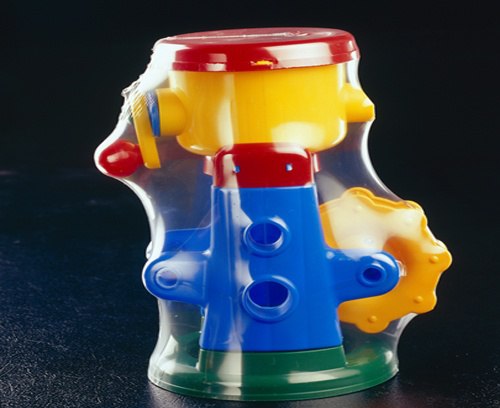
One of the greatest upsides of POF and PE shrink films is that they are recyclable. As sustainability becomes more important for Consumer Packaged Goods (CPG) businesses of all sizes, it’s critical to adopt packaging materials that meet sustainability standards. In addition, POF shrink film does not release harmful vapors during the heat-sealing process, as PVC does.
By taking advantage of shrink film's strength and durability, many brands have been able to remove corrugated packaging from their multi-pack products altogether. Heavy products can be securely wrapped in shrink without the need for a corrugated tray. Lightweight items (like single-serve chips) can be packaged in a polybag. This not only helps to reduce the cost of packaging but also minimizes your shelf footprint and opens up space in your facility.
With new technologies becoming available almost daily, you can further optimize your packaging for cost reduction by down-gauging or selecting a lower-width film. If you work with a packaging specialist to conduct a film audit for your packaging line, you’ll see what options are available to you.
The first step in understanding and evaluating the cost of implementing shrink wrap film into your process is asking yourself some essential questions. These will help determine what your priorities are and which shrink wrap film packaging line is right for your company.
Here is a video including some questions we are often asked about shrink film
Next, you’ll need to become more familiar with the math involved in shrink film packaging. Knowing your price per roll is great, but knowing your price per package is even better. Understanding what each package costs, how to calculate it and how you can save money will put you in a much better position to budget appropriately and maximize cost efficiency.
The math starts with a determination of your actual film usage and then leads into your actual cost per package:
Film length divided by film cut-off, minus the rewrap percentage, equals your film usage. Let’s say, for example, that your film length is the standard 4,375 feet per roll for 60-gauge center-folded film. Converted to inches, that is 52,500. Assume the film cut-off is 11 inches. If you divide this, it comes to roughly 4,772 packages per roll. Subtract the rewrap percentage of, say, 3%, and you get roughly 4,629 packages per roll of film.
We created a calculator to help you understand how many packages you can achieve per roll, along with your ideal package length (your cut-off). Determine this length and cut-off here, or check out some more math below:
4,375 feet per roll = 52,500 inches per roll
52,500 ÷ 11 inches of film cut-off = 4,772.73 packages per roll
4,772 × .03 re-wrap percentage = 143.16
4,772 - 143.16 = 4,629.57 packages per roll of film
This is much simpler math, as it’s just how much each roll costs you to purchase, divided by your film usage. So let’s say you are paying $128 per roll of film. Divide this number by 4,629 and then multiply by 1,000. You come up with a true package cost of $27.65 per thousand packages.
$128 per roll
4,629.57 packages per roll
128 ÷ 4,629.57 = .2765
.2765 × 1,000 = $27.65 per thousand packages
Use these calculations to formulate a solid expectation of your shrink wrap package price. Then consider the following tips for reducing that number.
Talk with your packaging provider to see if there are ways to get a better price per roll for your shrink film needs. Buy in larger quantities to get a bulk discount). Doing so can also save on shipping costs and delivery fees.
Many companies are not aware that PVC shrink film and other shrink wrap films are available in all sorts of sizes, not just full-inch increments. Reducing your film width from 12 inches to 11 inches would save you 4.2% in materials cost alone. Understand your ideal shrink film width with this easy-to-use shrink film width calculator!
It's important to note that custom-sizes will have a higher cost, but when using high volumes, packaging millions of products per year, you will see savings regardless.
It is essential to understand what film cut-off is and how to measure it. Film cut-off is the amount of film that you take off the roll for each package, and it can be determined by using these steps:
If you can reduce this number from 11 inches to 10 inches, for example, you will save 9.1% on material costs. This cut-off and packages-per-roll calculator can help you understand this easily!
In the old days, the shrink film used was only offered in 100, 75, 60, and 45 gauges. New technologies go as far as achieving the same integrity at 38 gauge. It's important to understand what gauge (thickness) of shrink film is ideal for your product. This is not only for costs but for protection throughout its lifecycle.
A different formulation may reduce your re-wraps. What many companies often overlook is that there could be more than one kind of shrink wrap film that works for a particular product.
Run a high-level audit of your packaging line. Send a product type through as an example. Do 100 runs as a test and check how many rejects you get out of 100. Create a spreadsheet with different criteria for failure (e.g., poor shrink, broken cross-seal, broken end-seal, burnout from too much heat, etc.). Perform a specific equipment assessment with the goal of finding your weak areas so you can fix them.
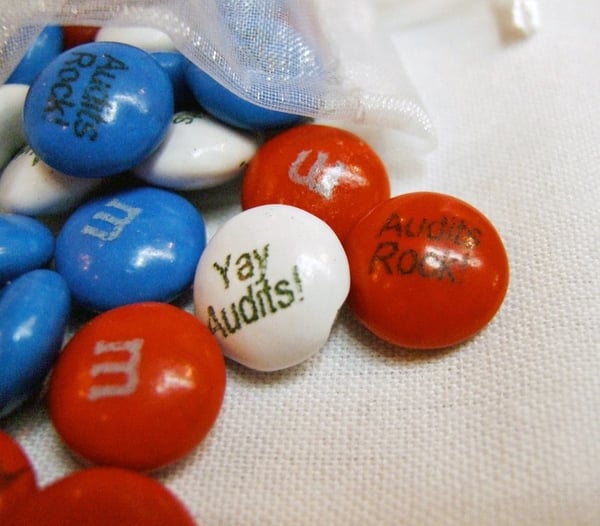
These are just a few of the many ways to save on your shrink film packaging line. Talk to your packaging supplier, perform research, and test new materials. You will likely be amazed at how much you can save by making the slightest tweaks.
Understand what other items are important to review when utilizing shrink film for product protection, beautification, cost savings, and more.
It's important to identify some specifics about your product to be packaged before diving into the details of the films available to you. Without question, a packaging supplier is key to selecting the appropriate film for your needs. Their industry experience and ability to understand your needs gives them the expertise to ascertain which types of films will and won’t work for your product.
Some of the packaging considerations you’ll need to be aware of include:
With so many types of flexible packaging film available, you are sure to find the right packaging for your product. Whether you need an option with a high melting point, one that emphasizes durability, or one that prioritizes recyclability and sustainability, there is a shrink film product available to suit your needs. With all of the opportunities for a custom finish to any product, it’s always important to do your research and consider your specific needs to determine the best options.
Also, you’ll need to do some homework regarding equipment. If you have an automatic shrink wrapper or are planning to purchase one in the future, it’s important to keep an eye on your bag length and running speeds. Sometimes operators adjust the bag length from the original specs to make running the line easier. This is particularly more noticeable on older pneumatic shrink wrap equipment. Running your film at just 1" larger than necessary can equate to 2,000 extra feet of film used per day. That’s approximately 118 wasted rolls of film.
Be sure to think about how capable your internal maintenance technicians are. Adding a shrink film wrapper to your packaging line will require technical support on a regular and as-needed basis. Assess your internal maintenance team’s comfort level with working on the new machine(s), and make sure you have a backup technician for when service is needed and your internal team can’t handle the repair.
Before purchasing and storing shrink film, make sure you know its storage requirements. You don’t want to try to work with climate-compromised packaging. Your supplier should have this information available if you’re unsure what your material requires. Overall, shrink packaging is best stored in temperatures between 30 and 77 degrees Fahrenheit. Naturally, summer and winter are the seasons that require you to be most attentive to your storage environment.

Your facility will likely be subject to high heat in the summer, if not during springtime. If shrink sleeves are kept in temperatures exceeding 100 degrees, they may prematurely shrink and compromise their ability to protect your goods. During these hot months, keep your shrink materials stored in the coolest areas of your facility without subjecting them to refrigeration.
They should be kept cool, but not too cold. The coolest spots in your warehouse are typically close to the floors – on the lowest part of your pallet racks – and away from windows or places that are subject to a lot of sunlight. You’ll also want to keep your shrink films away from high-traffic doors because the temperatures in these areas tend to fluctuate greatly.
Additionally, try to schedule your shrink film deliveries early in the day. That way, the materials won’t sit in the back of a hot trailer when traveling from warehouse to warehouse. Not only will you avoid the harshest hours of the sun, but you’ll also give yourself more time to store them before the temperature reaches its peak.

As mentioned, packaging films tend to become especially brittle in cold temperatures, which greatly reduces their stretching and shrinking properties. While the PVC may crack, it can even shatter like glass if left in extremely cold conditions for too long.
As in the summer, store your rolls away from doors to avoid temperature fluctuations. You also want to ensure rain or snow won’t create unwanted moisture in the rolls. If you’ve been using PVC shrink film to package frozen foods or other products that spend time in a freezer truck or refrigerator, consider switching to a polyolefin film. This is a more durable, food-safe, and recyclable material that will keep your package intact during transit and packaging.
When you take shrink film out of storage, you may not know how to tell if it’s been compromised. One key sign is sticky rolls. If PVC rolls stick together, they were likely exposed to too much heat. Don't risk downtime on the packaging line by trying to use them anyway. Skip over the rolls that are stuck together. Bagging and sagging are also signs of overheated film. The rolls may begin to sag on the edges or show bagging within their layers. Using these rolls can interfere with the tracking on your machines, so avoid using these compromised rolls as well.
Remember, even the highest-quality shrink film and packaging materials are apt to deteriorate when subject to these environmental factors. No matter what quality film rolls you’re purchasing, take the time to assess how you’ll store them to ensure they protect and present your product exactly as you’ve planned.

Finally, keep your target audience at the forefront of your packaging design. The type of material you choose is a part of your brand, so any disconnect between that and your brand’s message will confuse consumers and make them lose trust. To appeal to your customers, you have to research and understand them enough before you make these key marketing and branding decisions. Market research is a great way to learn what your target audience values and decide how to pair those details with your budget, transportation, and sustainability needs and goals. Always listen to your key demographic and cater to their needs specifically.
For a quick look at some additional considerations regarding your use of shrink wrap film, check out this free shrink film cheat sheet.